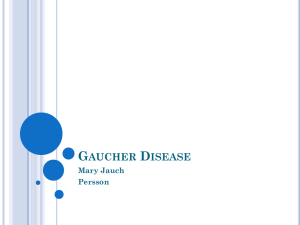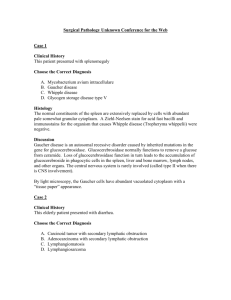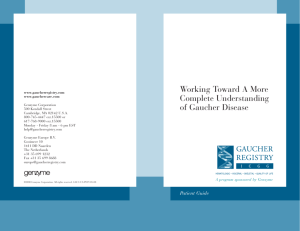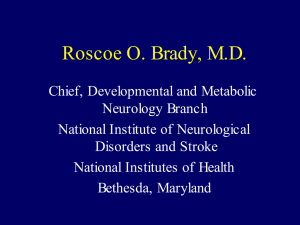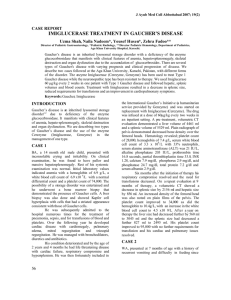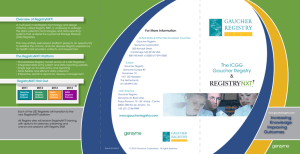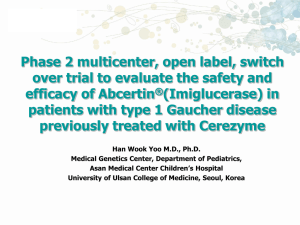CLIO Healthcare Awards 2011 Shire's Gaucher Awareness Month
advertisement
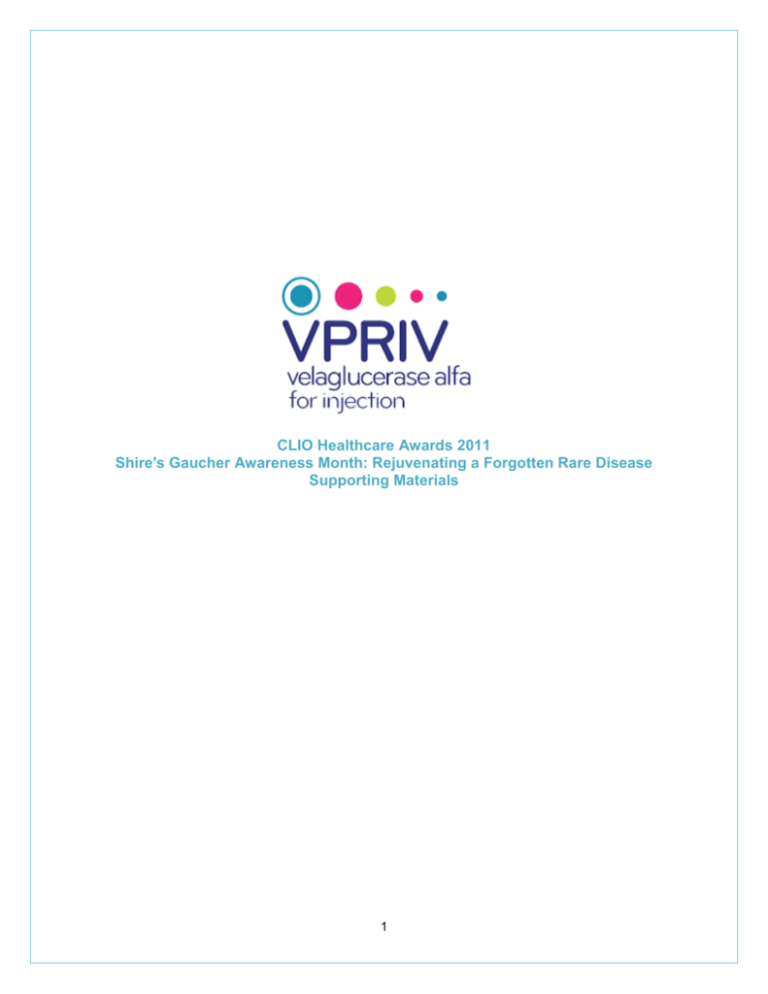
CLIO Healthcare Awards 2011 Shire's Gaucher Awareness Month: Rejuvenating a Forgotten Rare Disease Supporting Materials 1 Table of Contents Media Coverage ............................................................................................................................................ 3 Shire launches Facebook page for Gaucher disease month .................................................................... 3 Shire folks want you to "Like" them ........................................................................................................... 3 Gaucher and Velaglucerase Alfa Physician Quote Sheet ............................................................................ 5 Social Media Materials .................................................................................................................................. 7 Number of Views over 30 Day Period (September) .................................................................................. 7 Facebook/Twitter Updates......................................................................................................................... 7 Blog Posts that Appeared on Facebook Page ........................................................................................ 10 Twitter Page ................................................................................................................................................ 11 YouTube Initiatives ...................................................................................................................................... 12 Number of Views over 30 Day Period (September) ................................................................................ 12 Screen Shot of Video (FULL CLIP INCLUDED ON DISC) ...................................................................... 12 YouTube Search (third video in results) .................................................................................................. 13 Gaucher Awareness Month: Google Search .............................................................................................. 14 PR efforts resulted in first four search items ............................................................................................... 14 2 Media Coverage Shire launches Facebook page for Gaucher disease month By Julie M. Donnelly September 3, 2010 Shire plc has launched a Facebook page in honor of National Gaucher Awareness Month – a move designed to link the name of the company, and the name of the rare disease its drug, VPRIV, is treating. The drug sped to approval in March because the FDA urgently needed to blunt against shortages of a rival drug, Cerezyme, made by Genzyme Corp. For every visitor to the Facebook page who “Likes” it, Shire, which is based in the U.K. but has headquarters for its Human Genetic Therapies division in Massachusetts, will contribute $1 to the National Gaucher Foundation. So far, the page has 175 “Likes”, but it’s only been three days. The question is, could an appeal to the masses ever hope to translate into new customers for VPRIV, which treats a disease that affects only a very small number – 1 in 50,000 – of people worldwide? Possibly. Because the rare disease is often misdiagnosed or diagnosed very late, greater awareness of the disease, especially in the health care provider community, could lead to more correct diagnoses and more potential patients. But right now, Shire doesn’t need more customers. In June, the company established a waiting list for new patients who want to take the drug, as they work to ramp up capacity in Lexington. What Shire does need is to stem possible attrition from its drug as the Genzyme shortage eases. Genzyme announced last week that U.S. Cerezyme patients will begin to receive their full doses, and no one knows how many of the 850 patients worldwide now on VPRIV could switch back to Genzyme’s drug. Some Gaucher patients are torn between loyalty to Genzyme – the company that put Gaucher on the map – and appreciation for Shire, which has stepped in to help them when Genzyme could not. Shire folks want you to "Like" them By Julie Donnelly September 3, 2010 3 Shire plc has launched a Facebook page in honor of National Gaucher Awareness Month - a move designed to link the name of the company, and the name of the rare disease its drug, VPRIV, is treating. The drug sped to approval earlier this year because the FDA urgently needed to blunt against shortages of a rival drug Cerezyme, made by Genzyme Corp. For every visitor to the Facebook page who “Likes” it, Shire, which is based in the UK, but has headquarters for its Human Genetic Therapies division in Massachusetts, will contribute $1 to the National Gaucher Foundation. So far, the page has 109 “Likes”, but it’s only September 3. The question is, could an appeal to the masses ever hope to translate into new customers for VPRIV, which treats a disease that affects only a very small number - 1 in 50,000 - of people worldwide? Hmm. Possibly. Because the rare disease is often misdiagnosed, or diagnosed very late, greater awareness of the disease - especially in the health care provider community - could lead to more correct diagnoses, and more potential patients. But right now, Shire doesn’t need more customers. In June, the company established a waiting list for new patients who want to take the drug, as they work to ramp up capacity in Lexington. What Shire does need is to stem possible attrition from its drug as the Genzyme shortage eases. Genzyme announced last week that U.S. Cerezyme patients will begin to receive their full doses, and no one knows how many of the 850 patients worldwide now on VPRIV could switch back to Genzyme’s drug. Some Gaucher patients are torn between loyalty to Genzyme - the company that put Gaucher on the map - and appreciation for Shire, which has stepped in to help them when Genzyme could not. Like a page, give a dollar: National Gaucher Disease Awareness Month By Esther September 21, 2010 Just a quick heads-up: Shire Human Genetic Therapies is donating $1 to the National Gaucher Disease Foundation for every person who "likes" the National Gaucher Awareness Month Facebook page. It only takes a click, and you can help a great organization earn up to $10,000! What is Gaucher disease? An enzyme called beta-glucosidase is necessary for breaking down a specific fatty substance in the body. Lack of this enzyme, caused by a mutation in the GBA gene, causes this fatty substance to accumulate in the bone marrow, spleen, liver and other parts of the body. This can result in anemia, low platelet count, easy bruising and bleeding, bone pain and bone fractures, even with little trauma. 4 Gaucher and Velaglucerase Alfa Physician Quote Sheet Physician: Dr. Pramod Mistry Title: Director, Inherited Metabolic Liver Disease Clinic, Attending Physician, Yale-New Haven Hospital Specialty: Gastroenterology/Hepatology Pediatrics Hospital/Institution: Yale/New Haven Hospital “It has been very difficult managing patients during this shortage period (of Cerezyme). The arrival of velaglucerase alfa has already helped my patients enormously.” “I believe we are entering a new era of treatment, where we can treat future generations better than we have in the past. It is exciting to have velaglucerase alfa as a therapeutic option for patients.” “Shire is very dedicated, disciplined, and respectful to patients’ and physicians’ needs.” Physician: Dr. Gregory Grabowski Title: Director, Division of Human Genetics and Director, Medical Genetics Training Program Specialty: Lysosomal storage diseases; molecular enzymology; gaucher disease; fabry disease; molecular pathogenesis Hospital/Institution: Cincinnati Children’s Hospital “I have been working with Gaucher for over 30 years, in the beginning there was nothing to do but to treat the symptoms. The ERT trials in 1993 were transformational for patients. ERT has radically improved the life of patients with Gaucher disease.” “The Gaucher community has gone through an earthquake with the shortage of drug supply and the fear that the symptoms of their disease may return.” “The environment is changing, companies need to remember to be hi-tech, but also hi-touch with highly personalized care.” 5 Physician: Dr. Gregory Pastores Title: Associate Professor Specialty: Human Genetics; Genetic Diseases of the Nervous System Hospital/Institution: NYU Langone Medical Center “The drug supply shortage has altered the landscape of the treatment of Gaucher disease, now we have more choices and we are ensured there is never an interruption again.” “We can now get further than we’ve been in the past, now we can see if we can get patients further in their treatment goals and provide an enhanced quality of life.” “There is some exciting data out there right now that suggests that the (cellular) uptake could be greater by two-fold and more efficient for patients.” 6 Facebook Initiative Number of Views over 30 Day Period (September) Facebook/Twitter Updates Date September 1 September 1 (second post) September 2 September 3 Facebook September is Gaucher Disease Awareness Month! We will be posting information about Gaucher disease every day to spread awareness. Come back and visit to learn more each day. Shire will donate $1 to the National Gaucher Foundation for each person who “likes” this page during the month of September. Invite your friends here to learn more about Gaucher disease. Gaucher is pronounced “go-shay” and is one member of a family of rare genetic diseases called lysosomal storage disorders. Gaucher disease results from a specific enzyme deficiency in the body, caused by a genetic mutation inherited from both parents. September 4 Gaucher disease is an inherited metabolic disorder in which harmful quantities of a fatty substance accumulate in certain parts of the body. September 5 Common symptoms of Gaucher disease include bone disease, enlarged liver and spleen, anemia, and low platelet count. 7 Twitter September is Gaucher Disease Awareness Month! We will share information about Gaucher disease every day. Shire will donate $1 to the NGF for each person who “likes” our Facebook page. Learn more about Gaucher disease here. Gaucher is pronounced “go-shay” and is a lysosomal storage disorder. Gaucher disease results from a specific enzyme deficiency in the body, caused by a genetic mutation inherited from both parents. Gaucher disease is an inherited metabolic disorder that leads to the accumulation of a fatty substance in certain parts of the body. Common symptoms of Gaucher disease include bone disease, enlarged liver and spleen, anemia, and low platelet count. September 6 Gaucher disease is a multi-system disease with a wide variation in the severity of symptoms. September 6 (second post) It is Day 6 of Gaucher Disease Awareness Month. We have raised XX for the NGF so far! September 7 In the past, the diagnosis of Gaucher disease was typically made by examining a patient’s bone marrow or performing biopsies on the liver or spleen to look for cells filled with storage material. Today, Gaucher disease can now be diagnosed with a single blood test. Gaucher disease is caused by a recessive gene on chromosome 1 and affects both males and females. Help spread awareness for Gaucher disease during the month of September! Shire is donating $1 to the NGF for each person who “likes” this page. September 8 September 9 September 10 The features of Gaucher disease range from mild to severe and may appear anytime from childhood to adulthood. September 11 Gaucher disease has an incidence of about 1 in 57,000 live births. Gaucher disease is named after the French doctor Philippe Gaucher, who originally described it in 1882. Gaucher disease has been divided into three subtypes depending on the presence (or absence) of neurological involvement. September 12 September 13 September 14 All three types of Gaucher disease are inherited as autosomal recessive traits and have equal chance of affecting males and females. September 15 We are halfway through Gaucher Disease Awareness Month and have raised XX for the National Gaucher Foundation! Type 1 Gaucher disease is the most common type affecting 95% of people with Gaucher disease. It is most prevalent among individuals of Ashkenazi Jewish descent, although all three types can affect individuals of any ethnic or racial background. Type 1 Gaucher disease is characterized as lacking central nervous system involvement. Typical symptoms include bone disease, enlargement of the liver and spleen, anemia, and low platelet count. Type 2 Gaucher disease is characterized by central nervous system (CNS) involvement and symptoms are typically present before the age of two. September 15 (second post) September 16 September 17 8 Gaucher disease is a multi-system disease with a wide variation in the severity of symptoms It is Day 6 of Gaucher Disease Awareness Month. We have raised XX for the NGF so far! Currently, Gaucher disease can be diagnosed with a single blood test. Gaucher disease is caused by a recessive gene on chromosome 1 and affects both males and females. Help spread awareness for Gaucher disease during the month of September! Shire is donating $1 for each person who “likes” the Facebook page. The features of Gaucher disease range from mild to severe and may appear anytime from childhood to adulthood. Gaucher disease has an incidence of about 1 in 57,000 live births. Gaucher disease is named after the French doctor Philippe Gaucher, who originally described it in 1882. Gaucher disease has been divided into three subtypes depending on the presence (or absence) of neurological involvement. All 3 types of Gaucher disease are inherited as autosomal recessive traits and have equal chance of affecting males and females. We are halfway through Gaucher Disease Awareness Month and have raised XX for the NGF! Type 1 Gaucher disease is most prevalent among Ashkenazi Jewish descent, although all 3 types may affect individuals of any ethnic background. Type 1 Gaucher disease is characterized as lacking CNS involvement and affects the bone, liver/spleen, and platelet count Type 2 Gaucher disease is characterized by central nervous system (CNS) involvement and symptoms are typically present before September 18 Type 3 Gaucher disease includes CNS involvement, but is much more mild and slowly progressive compared to types 1 and 2. September 19 The prevalence of neuropathic Gaucher disease (types 2 and 3) varies across ethnic groups, but appears to be higher among non-Caucasians. September 20 The symptomatic spectrum of Gaucher disease is broad, ranging from no outward symptoms to severe disability. September 21 Gaucher disease can cause anemia, fatigue, easy bruising and bleeding, nosebleeds, osteoporosis, bone pain and easily broken bones, and swollen stomach due to enlarged liver and/or spleen. Gaucher disease is a mutation of the gene, where once established, is transmitted as a simple dominant hereditary trait. September 22 September 23 September 24 September 25 September 26 September 27 September 28 September 29 September 30 The carrier rate for the mutations which cause Gaucher disease may be as high as 1 in 15 Jewish people of Eastern European ancestry, and 1 in 100 of the general population. Gaucher disease is one of more than 6000 rare diseases that affect less than 200,000 people in the U.S.(Defined by the Orphan Drug Act) The severity of Gaucher disease varies considerably. While some may experience symptoms from a young age, in others, it may progress at a slower rate with symptoms becoming apparent later in life. Regardless of a patient’s age, Gaucher disease is often progressive and can affect the function of many organ systems, including the liver, spleen, lungs, brain, metabolism, and bone marrow. Prenatal testing for pregnancies at increased risk for Gaucher disease is possible when two disease-causing mutations in a family are known. Though carriers do not have a diagnosis of Gaucher disease, they can still pass it along to their biological children. If 2 carriers of Gaucher disease have children, there is a chance that their children may have the disease. Unlike many more severe recessive disorders, most people with type 1 Gaucher disease can have children. Genetic counseling is available for those who have a family history, or are found to be carriers, of Gaucher disease. 9 the age of two Type 3 Gaucher disease can also include CNS involvement but is much milder and slowly progressive compared to types 1 and 2 The prevalence of neuropathic Gaucher disease (types 2 and 3) varies across ethnic groups, but appears to be higher among nonCaucasians. The symptomatic spectrum of Gaucher disease is broad, ranging from no outward symptoms to severe disability. Gaucher disease can cause anemia, fatigue, easy bruising/bleeding, osteoporosis, and swollen stomach due to enlarged liver and/or spleen. Gaucher disease is a mutation of the gene, where once established, is transmitted as a simple dominant hereditary trait. The carrier rate for mutations which cause Gaucher disease may be as high as 1 in 15 Jewish people of Eastern European ancestry. Gaucher disease is one of more than 6000 rare diseases that affect less than 200,000 people in the U.S. While some experience Gaucher disease symptoms from a young age, others may experience symptoms later in life. Regardless of a patient’s age, Gaucher disease is often progressive and can affect the function of many organ systems. Prenatal testing for pregnancies at increased risk for Gaucher disease is possible when two disease-causing mutations in a family are known. If 2 carriers of Gaucher disease have children, there is a chance that their children may have the disease. Unlike many more severe recessive disorders, most people with type 1 Gaucher disease can have children. Genetic counseling is available for those who have a family history, or are found to be carriers, of Gaucher disease. September 30 (second post) Thank you for your support. We have raised a total of XX for the NGF this month! Thank you for your support. We have raised a total of XX for the NGF this month! Blog Posts that Appeared on Facebook Page #1 Past, Present and Future of Gaucher Disease By Dr. Norman Barton, Senior Fellow and Disease Expert, Shire HGT In celebration of National Gaucher Disease Awareness Month, I wish to contribute to a series of blog posts in an effort to connect with the community and to increase awareness for this inherited metabolic disease. I have spent the vast majority of my professional life working with rare genetic disorders including Gaucher disease. More than 20 years ago, I directed the landmark study at the NIH that lead to availability of the first enzyme replacement therapy for the disorder and I am thrilled to see how far we’ve come. Now, 20 years later, the outlook is especially bright with so many developments in Gaucher disease treatment. Although we have come a long way in the past few decades, there are still unmet needs and it is remains essential to increase awareness and education about the disease. We need increased physician awareness in order to diagnose patients accurately and patients need to be educated so they can recognize the health concerns that may lead to a diagnosis and be their own advocates. In the past, diagnosis was quite a painful process for patients. Examining bone marrow or other tissues was the only effective way to diagnose Gaucher disease. Today, presence or absence of the disease can be established from a single blood test. Genetic testing can even be done using a simple saliva sample. Though Gaucher disease primarily affects the Ashkenazi Jewish community, it can affect individuals of any ethnicity. This is why it is so important for everyone to be aware. th About 24 years ago, Congress designated October 19 as the start of “Gaucher Disease Awareness Week" and requested that President Ronald Reagan issue a proclamation in observance of that week. Today, Gaucher Disease Awareness Week has evolved into Gaucher Disease Awareness Month to help spread the message as far as possible further demonstrating the progress we’ve made. For those of us close to the Gaucher community, we all appreciate that a rare disease is not so rare when it affects you or a loved one. Please stay tuned for more blog posts throughout September!! Genetics as a risk factor By Dr. Gabriel Cohn, medical director, Shire HGT From reading prior information provided on this site, you are probably aware that Gaucher disease is a rare genetic disorder, but perhaps it will help to explain what exactly this means. Gaucher disease as an autosomal recessive disorder, which means that a person with Gaucher disease has genetic changes (mutations) in both copies of the gene related to this disorder. We have two copies of most genes, one copy inherited from each parent. The parents of an individual with Gaucher disease usually carry one copy of this gene with a mutation and one gene that is fully functional. These parents are referred to as carriers and do not show any signs or symptoms of this disease. If both parents are carriers and each parent passes down the gene with a mutation, their child will have Gaucher disease. 10 Patients often ask me how they can prevent passing Gaucher disease on to their children. My recommendation for those who have a family history of Gaucher, or are found to be carriers of Gaucher disease, is to meet with a clinical geneticist or genetic counselor and find out more about what is right for you and your family through genetic counseling. Genetic counseling can provide you and your family with not only valuable medical information, but also support in adjusting to new knowledge and decision-making that is aligned with your personal beliefs and ethics. This can be particularly helpful in family planning and decision-making, such as prenatal testing. No one can make this decision for you, but a genetic counselor can give you the tools you need to be informed. For more information on genetic counseling, visit the National Society of Genetic Counselors (NSGC) at www.nsgc.org. Twitter Page 11 YouTube Initiative Number of Views over 30 Day Period (September) Screen Shot of Video (FULL CLIP INCLUDED ON DISC) 12 YouTube Search (third video in results) 13 Gaucher Awareness Month: Google Search (PR efforts resulted in first four search items on Google) 14
